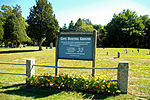Fort Hill Rural Historic District

The Fort Hill Rural Historic District is a historic district encompassing two farmsteads with more than 200 years of history in Eastham, Massachusetts. The district is a 100-acre (40 ha) area of forest, fields, and salt marshes that was owned by the Knowles and Penninman families from 1742 to 1941. It has been part of the Cape Cod National Seashore since 1961. The area is dominated by the rise called "Fort Hill", which provides extensive views of the area and has its own rich history. The district includes the Edward Penniman House and Barn, previously listed on the National Register of Historic Places, and the Nauset Archeological District, a National Historic Landmark.The district was listed on the National Register of Historic Places in 2001.
Excerpt from the Wikipedia article Fort Hill Rural Historic District (License: CC BY-SA 3.0, Authors, Images).Fort Hill Rural Historic District
Red Maple Swamp Trail,
Geographical coordinates (GPS) Address Nearby Places Show on map
Geographical coordinates (GPS)
| Latitude | Longitude |
|---|---|
| N 41.819444444444 ° | E -69.965555555556 ° |
Address
Red Maple Swamp Trail
Red Maple Swamp Trail
02642
Massachusetts, United States
Open on Google Maps








